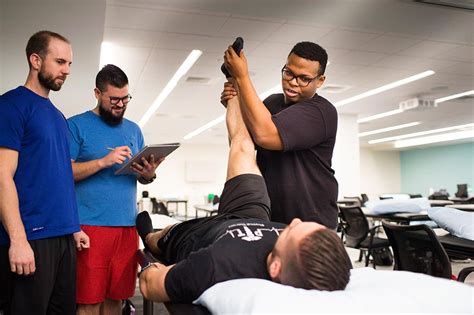Intro
Physical therapist (PT) jobs are in high demand, and the career opportunities and growth prospects are vast. As the healthcare industry continues to evolve, the need for skilled physical therapists to provide high-quality patient care and rehabilitation services is on the rise. In this article, we will delve into the world of physical therapist jobs, exploring the various career paths, job requirements, and growth opportunities available to professionals in this field.

What is a Physical Therapist?
A physical therapist is a healthcare professional who specializes in the diagnosis, treatment, and prevention of physical disabilities and injuries. PTs use a variety of techniques, including exercise, manual therapy, and education, to help patients achieve optimal physical function and mobility. Physical therapists work in a range of settings, including hospitals, clinics, private practices, and sports teams.
Types of Physical Therapist Jobs
There are several types of physical therapist jobs, each with its own unique requirements and responsibilities. Some of the most common types of PT jobs include:
- Acute Care Physical Therapist: Works in hospitals and acute care settings to provide rehabilitation services to patients with complex medical conditions.
- Outpatient Physical Therapist: Works in clinics and private practices to provide rehabilitation services to patients with a range of conditions, from sports injuries to chronic diseases.
- Pediatric Physical Therapist: Specializes in the treatment of children and adolescents with physical disabilities and injuries.
- Geriatric Physical Therapist: Works with older adults to prevent and treat age-related physical declines and disabilities.
- Sports Physical Therapist: Works with athletes to prevent and treat sports-related injuries and improve performance.
Job Requirements and Skills
To become a physical therapist, you will need to possess a range of skills and qualifications, including:
- Education: A Doctor of Physical Therapy (DPT) degree from an accredited program.
- Licensure: A physical therapy license in the state where you wish to practice.
- Communication Skills: Strong communication and interpersonal skills to work effectively with patients, families, and healthcare teams.
- Physical Abilities: The physical stamina to lift, move, and manipulate patients and equipment.
- Problem-Solving Skills: The ability to analyze complex medical conditions and develop effective treatment plans.

Career Opportunities and Growth Prospects
The demand for physical therapists is high, and the job market is expected to continue growing in the coming years. According to the Bureau of Labor Statistics (BLS), employment of physical therapists is projected to grow 22% from 2020 to 2030, much faster than the average for all occupations.
Some of the factors driving this growth include:
- Aging Population: The aging population is driving demand for physical therapy services to prevent and treat age-related physical declines and disabilities.
- Chronic Diseases: The increasing prevalence of chronic diseases, such as diabetes and obesity, is driving demand for physical therapy services to manage and treat these conditions.
- Sports and Fitness: The growing interest in sports and fitness is driving demand for physical therapists to provide injury prevention and treatment services to athletes.
Salary and Benefits
Physical therapists are among the highest-paid healthcare professionals, with median salaries ranging from $85,000 to over $120,000 per year, depending on experience and location. In addition to salary, physical therapists often receive a range of benefits, including:
- Health Insurance: Comprehensive health insurance coverage for themselves and their families.
- Retirement Plans: Employer-sponsored retirement plans, such as 401(k) or pension plans.
- Paid Time Off: Generous paid time off policies, including vacation and sick leave.

Specializations and Certifications
Physical therapists can pursue a range of specializations and certifications to advance their careers and enhance their skills. Some of the most common specializations and certifications include:
- Orthopedic Certification: The American Board of Physical Therapy Specialties (ABPTS) offers certification in orthopedics, which demonstrates expertise in the treatment of musculoskeletal conditions.
- Sports Certification: The ABPTS offers certification in sports physical therapy, which demonstrates expertise in the treatment of sports-related injuries and conditions.
- Neurological Certification: The ABPTS offers certification in neurological physical therapy, which demonstrates expertise in the treatment of neurological conditions, such as stroke and spinal cord injury.
Continuing Education and Professional Development
Physical therapists are required to complete ongoing continuing education and professional development to maintain their licensure and stay current with the latest research and best practices. Some of the ways to pursue continuing education and professional development include:
- Conferences and Workshops: Attend conferences and workshops to learn from experts in the field and network with colleagues.
- Online Courses: Complete online courses and webinars to enhance skills and knowledge in specific areas.
- Professional Memberships: Join professional organizations, such as the American Physical Therapy Association (APTA), to access resources, networking opportunities, and continuing education.

Conclusion
Physical therapist jobs offer a range of career opportunities and growth prospects for professionals who are passionate about helping others and advancing their skills and knowledge. With the demand for physical therapy services on the rise, now is an exciting time to pursue a career in this field. Whether you are just starting out or looking to advance your career, we hope this article has provided valuable insights and information to help you achieve your goals.
What is the average salary for a physical therapist?
+The average salary for a physical therapist varies depending on experience and location, but median salaries range from $85,000 to over $120,000 per year.
What are the job requirements for a physical therapist?
+To become a physical therapist, you will need to possess a Doctor of Physical Therapy (DPT) degree from an accredited program, a physical therapy license in the state where you wish to practice, and strong communication and interpersonal skills.
What are the growth prospects for physical therapist jobs?
+The demand for physical therapists is high, and the job market is expected to continue growing in the coming years, with employment projected to grow 22% from 2020 to 2030, much faster than the average for all occupations.
